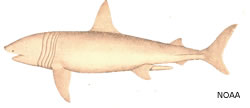 There is one species in this family of sharks. Basking sharks are found in cool and temperate regions of all the world's oceans. Basking sharks are the second largest living fish, only the whale shark is larger. Adult basking sharks can be 20-30 feet long. Basking sharks have five pairs of very long gill slits that curve all the way over the back of their heads! They have small eyes, two dorsal fins, and an anal fin. Basking sharks have huge mouths that extend past their eyes! They have lots of very small hooked teeth. Basking sharks are filter feeders. That means they swim through the water with their big mouths wide open and take in huge amounts of water. Food like small crustaceans, fish eggs, and larvae is collected in gill rakers in their gill slits! They feed at or near the surface of the water, usually close to the shoreline. Basking sharks are sometimes called
sunfish, sailfish sharks, bone sharks, or big mouth sharks. There is one species in this family of sharks. Basking sharks are found in cool and temperate regions of all the world's oceans. Basking sharks are the second largest living fish, only the whale shark is larger. Adult basking sharks can be 20-30 feet long. Basking sharks have five pairs of very long gill slits that curve all the way over the back of their heads! They have small eyes, two dorsal fins, and an anal fin. Basking sharks have huge mouths that extend past their eyes! They have lots of very small hooked teeth. Basking sharks are filter feeders. That means they swim through the water with their big mouths wide open and take in huge amounts of water. Food like small crustaceans, fish eggs, and larvae is collected in gill rakers in their gill slits! They feed at or near the surface of the water, usually close to the shoreline. Basking sharks are sometimes called
sunfish, sailfish sharks, bone sharks, or big mouth sharks.
World Status Key
 Least Concern Least Concern  Near Threatened Near Threatened  Vulnerable Vulnerable  Endangered Endangered  Critically Endangered Critically Endangered
 Extinct in the Wild Extinct in the Wild  Extinct Extinct
Status and range is taken from ICUN Redlist. If no status is listed, there is not enough data to establish status.
US Status Key
 Threatened in US Threatened in US  Threatened in NH Threatened in NH  Endangered in US Endangered in US  Endangered in NH Endangered in NH  Introduced Introduced
Status taken from US Fish and Wildlife and NH Fish and Game
New Hampshire Species |
|
North/Central American Species |
Basking Shark- Cetorhinus maximus  |
|
None
|
Additional Information
Key:  Profile Profile  Photos Photos  Video Video  Audio Audio
Basking Shark- Cetorhinus maximus              
The basking shark is one of only three plankton-feeding shark species.
Source: Basking Shark Project Intended Audience: General Reading Level: Middle School
Basking Shark- Cetorhinus maximus              
Basking sharks travel alone, in pairs, or in schools of up to 100 members.
Source: Enchanted Learning Intended Audience: Students Reading Level: Elementary School
Basking Shark- Cetorhinus maximus              
Basking sharks sometimes enter bays and estuaries.
Source: Florida Museum of Natural History Intended Audience: Students Reading Level: High School
Basking Shark- Cetorhinus maximus              
Basking sharks travel at a rate of around three miles per hour
Source: BBC Nature Intended Audience: General Reading Level: Middle School
|